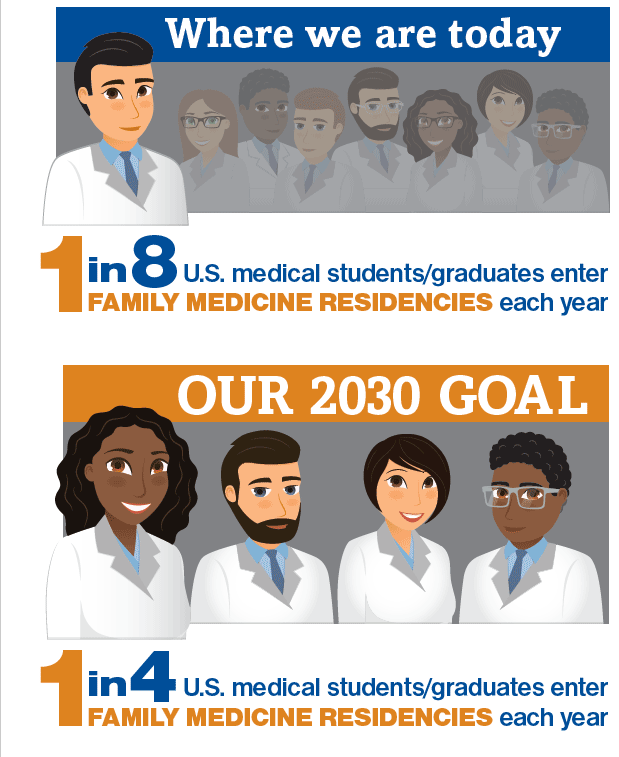Match Day 2021: Another Record Year of Family Medicine Growth in the Match
News Release: Family Medicine Welcomes New Residents and Celebrates Another Record Year of Growth in the Match
Today marks a historic year with an all-time record high of students matching into family medicine residency programs, according to the National Residency Matching Program® Main Residency Match results released Friday. Family medicine marks 12 years in a row of growth for residents matching into the specialty, the last 10 years of which have broken all-time records.
AAFP Analysis: 2021 Match® Results for Family Medicine
The American Academy of Family Physicians’ brief analysis of the family medicine results of the annual National Resident Matching Program Main Residency Match® provides a snapshot of a major input into the primary care workforce pipeline.
AAFP News: Match Day Is a Record-breaker for Family Medicine
“More family physicians means better access to care and better health outcomes for our country,”
said Ada Stewart, MD, president of the American Academy of Family Physicians.
“The next generation of family physicians recognizes the vital role our specialty plays in addressing
social issues -- including health equity and racism -- and the impact those issues have on health."
Graph: Family Medicine in the NRMP Match 2011-2021
This year, the total number of NRMP Match participants matching into family medicine was 4,493, up 158 from the 4,335 in 2020. 2020 was the first year that there was not an American Osteopathic Association match as U.S. graduate medical education programs transitioned to single accreditation through the Accreditation Council on Graduate Medical Education. As such, the vast majority of students and graduates entering ACGME-accredited residency programs now do so through the NRMP Match.
.jpg)
America Needs More Family Doctors: 25x2030
The U.S. is facing a worsening primary care physician shortage. A robust family medicine workforce is critical to ensure patients everywhere have appropriate, effective, and accessible care for generations to come. The AAFP and seven other national and international family medicine organizations envision a future in which one in four U.S. medical students pursues a career in family medicine.

Peer-reviewed journal publications
Family Medicine:
Collaborating to Achieve the Optimal Family Medicine Workforce
When the Family Medicine for America’s Health Workforce Education and Development Tactic Team began its work in December 2014, one of its charges from the FMAHealth Board was to increase family physician production to achieve the diverse primary care workforce the United States needs. The WEDTT created a multilevel interfunctional team to work on this priority initiative that included a focus on student, resident, and early-career physician involvement and leadership development. One major outcome was the adoption of a shared aim, known as 25 x 2030.
Annals of Family Medicine:
The Future of Family Medicine Residency Education: The Specialty Has Spoken
An update from representatives of the specialty of Family Medicine who came together at the fourth Starfield Summit to provide input for the development of the next version of ACGME Program Requirements for Graduate Medical Education in Family Medicine, expected to be implemented in 2022.
Introducing the Best Practice Guide for Strategic Planning to Increase Student Choice of Family Medicine
The family of Family Medicine has created several initiatives to increase student choice of Family Medicine over the years. The most recent is a set of strategies recommended by the Family Medicine for America’s Health (FMAHealth) Workforce Education and Development.Tactic Team which has become the current collective effort to increase student interest, America Needs More Family Doctors: 25x2030.
Estimating the Residency Expansion Required to Avoid Projected Primary Care Physician Shortages by 2035
More than 44,000 primary care physicians will be needed by 2035. Current primary care production rates will be unable to meet demand, resulting in a shortage in excess of 33,000 primary care physicians.
A Shared Aim for Student Choice of Family Medicine: An Update from ADFM and Family Medicine for America's Health
Recently, through the Family Medicine for America’s Health Workforce team, 8 family medicine organizations endorsed a “shared aim” to: increase the percentage of US senior allopathic and osteopathic medical students choosing family medicine from 12% to 25% by 2030. Twenty-five percent is a stretch goal aligning current efforts and resources with the ultimate primary care workforce goal of 40%.